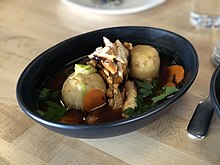
Ashkenazi Jewish cuisine is an assortment of cooking traditions that was developed by the Ashkenazi Jews of Central, Eastern, Northwestern and Northern Europe, and their descendants, particularly in the United States and other Western countries.
Ashkenazi Jewish foods have frequently been unique to Ashkenazi Jewish communities, and they frequently consist of local ingredients (such as beets, cabbage, and potato), all of which are generally prepared in accordance with the laws of kashrut. Some of these ingredients have not been popular in local or neighbouring non-Jewish communities due to a history of limited interaction between Ashkenazi Jews and non-Jews.[citation needed]
The cuisine is largely based on ingredients that were affordable to the historically poor Ashkenazi Jewish community of Europe, and it is frequently composed of ingredients that were readily available and affordable in the regions and communities of Europe in which Ashkenazi Jews lived. Some ingredients were considered less desirable than other ingredients, such as brisket, chicken liver, and artichokes, among other ingredients, and as a result, these items were rarely used by gentile neighbours of Ashkenazi Jews.
Meat is ritually slaughtered in the shechita process, and it is also soaked and salted. Meat dishes are a prominent feature of Shabbat, festivals, and celebratory meals. Braised meats such as brisket feature heavily, as do root vegetables such as potatoes, carrots, and parsnips which are used in such dishes as latkes, matzo ball soup, and tzimmes (a braised fruit and vegetable dish which may also contain meat). Cooked, stuffed and baked vegetables such as stuffed cabbage and, in some regions, stuffed peppers are central to the cuisine.
Due to the lack of availability of olive oil and other fats which are commonplace in Jewish cooking, rendered fat from leftover poultry skins (gribenes) called schmaltz is used in fleishig (meat) dishes, while butter is traditionally used in milchig (dairy) dishes.[1][2] Since the advent of mass-produced vegetable oils (particularly in the United States and Canada) such as canola oil, many baked goods have been made with oils rather than butter, so as to render them pareve.
© MMXXIII Rich X Search. We shall prevail. All rights reserved. Rich X Search
